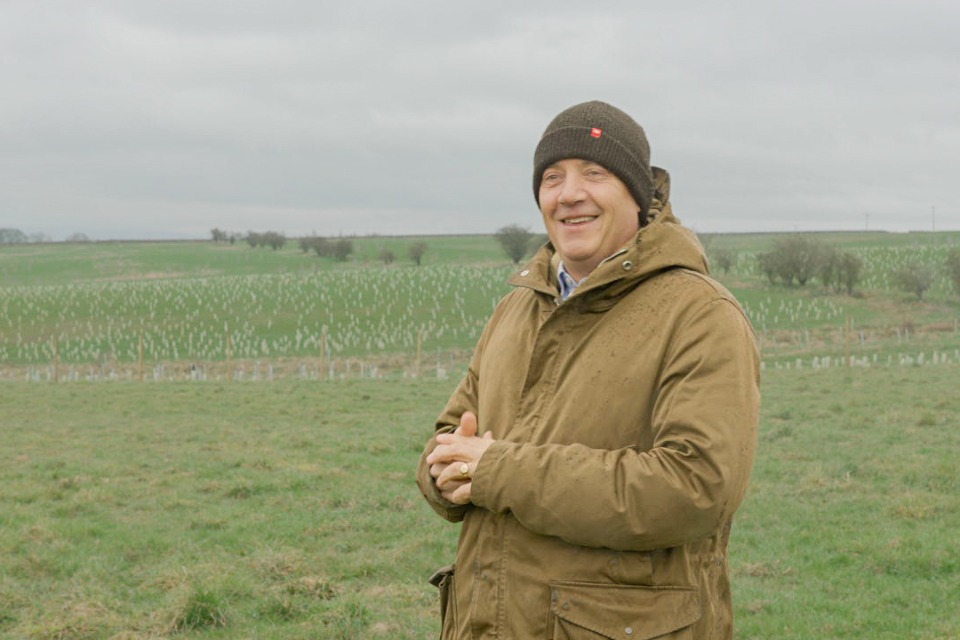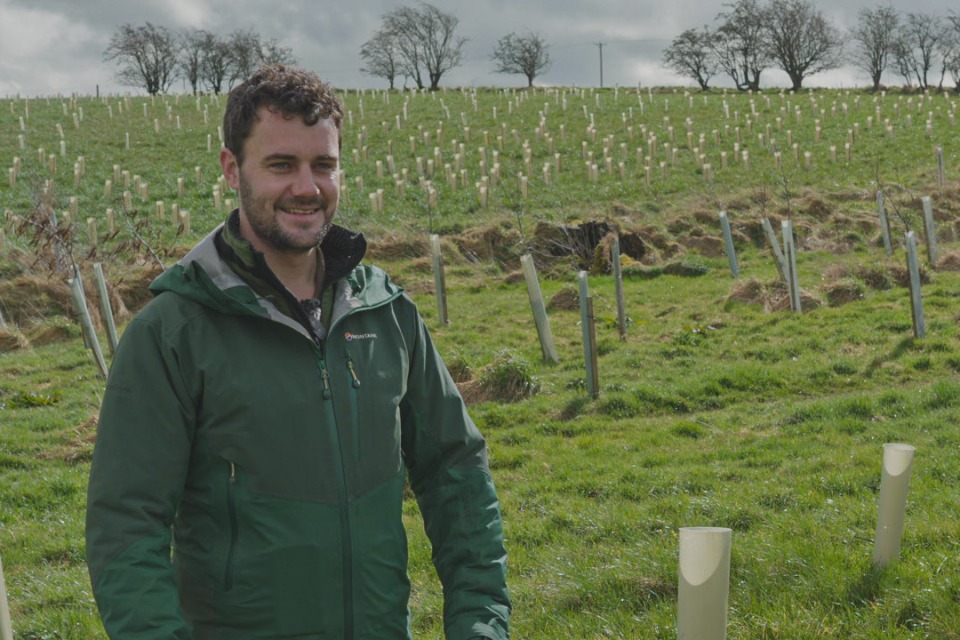Read how funding from the Woodland Creation Planning Grant and England Woodland Creation Offer helped to create woodland in Cumbria.
Key facts
- site: Ladybeck Wood, Cumbria
- size: 51 hectares
- type: mixed broadleaf
- species: wild cherry, sycamore, silver birch, sessile oak, crab apple, hawthorn, Scots pine, field maple, common alder, aspen, hazel, goat willow and native black poplar
- date planted: December 2023
- grants: Woodland Creation Planning Grant, England Woodland Creation Offer (EWCO), and Countryside Stewardship
- main objective: to bolster existing farmer and timber enterprises with native woodland

Tree seedlings growing on Ladybeck Wood. Copyright Lowther Estate.
Ladybeck Wood in the Lake District is an inspiring landscape of seedlings and whips. In December 2023, around 51 hectares of new woodland was planted on Lowther Estate across 2 locations bordering the Eastern Lakes in Cumbria.
The newly planted woods promise to be a boon for nature recovery in the area as the trees grow and mature. The predominantly broadleaf woodlands are just the latest planted on the estate, which also boasts large timber crops.
With local biodiversity and business resilience in mind, the new woods show how planting under EWCO can help to provide benefits to landowners, nature and the wider community.
Choosing woodland creation
The woodland project at Ladybeck Wood began when a large section of land came back under the management of Lowther Estate. The retirement of a long-term tenant meant the estate had big decisions to make about the best use for this land. They considered further expanding the estate's food production enterprises, however, due to the soil quality, this was unlikely to be a profitable venture.
Ultimately, woodland creation was chosen for the environmental benefits and the diversification it offered the estate - allowing them to make their income streams more resilient. Producing carbon credits on top of grant funding would provide additional income and allow the estate to offset some of their own emissions which made the woods an appealing option.

David Bliss, CEO Lowther Estate. Copyright Lowther Estate.
The planning stages
Ladybeck Wood was initially planned across 97 hectares with 2 locations between Tirril, Askham and Helton. Lowther Estate applied for the Woodland Creation Planning Grant , which helped them plan the scheme and further assess the viability of planting woodland in the area.
Half of the proposed site was inside the bounds of a National Park and World Heritage Site. This required consultation around the visual impact of woodland on the National Park area.
It was decided that tree planting in this area would be as wood pasture, as this would blend better with the landscape, whilst allowing the estate to use it for grazing cows as part of its extensive beef production business. The wood pasture was funded under a Natural England wood pasture scheme through Countryside Stewardship .
The portion of land from the Ladybeck Wood plan that was outside of the National Park required an Environmental Impact Assessment screening, Landscape Impact Assessment and breeding wader surveys. The planning grant assisted with the funding for the required surveys and the costs of producing their UK Forestry Standard compliant woodland creation plan.
Funding the woodland creation project
In total, around 51 hectares were planted outside the National Park with support from EWCO which covered 100% of standard costs. The sites were eligible for additional stackable payments under EWCO for delivering wider benefits to nature recovery and the environment.
Blocks were eligible for nature recovery (£69,000), water quality (£20,400) and flood risk (£21,800) contributions, providing over £111,000 in stackable payments. However, the landowner opted not to take water quality and flood risk payments to take advantage of third-party funding to support the landowners' objectives. Yearly maintenance payments of £400 from EWCO will help to establish the woodland as it grows.
The woodland is registered with Forest Carbon , who act as an intermediary and project developer for the Woodland Carbon Code. This allows the estate to use and sell carbon credits as their woodland matures.
The current strategy is to sell a third of the credits, which will help provide income from the woods. Lowther Estate will then use two thirds of these credits for offsetting their own carbon emissions.

Kelvin Archer, Forestry and Conservation Manager, Lowther Estate. Copyright Lowther Estate.
Looking forward
Planting took place between November and December 2023 and the EWCO agreement will continue for the next 15 years.
The planting of Ladybeck Wood will help Lowther Estate to reap benefits from areas of their land that were difficult to farm. As the woodland grows, it will also provide benefits for the land, and the wider community through water quality and nature recovery improvements.
Top tips
Lowther Estate landowners recommend the following:
- seek advice from the Forestry Commission Woodland Officers and Land Use Advisors as early as possible
- think big: scale was important to Lowther Estate's woodland creation ambitions and allowed the estate to the make the most of the financial incentives on offer
- consider registering your land with the Woodland Carbon Code before planting, as this offers the estate long-term income from slower growing broadleaf species






